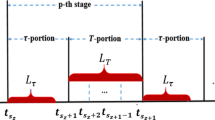Abstract
This work studies the reachability and observability of discrete-time descriptor systems and considers the following problem: Given a matrix pair (E, A), find a matrix B (C) such that the corresponding descriptor system is not reachable (observable). The computation of such a matrix can give us a set of conditions that can then be taken into account when constructing the matrix B (C) to make the system reachable (observable). The above problem is solved by working on the equivalent causal and noncausal subsystems that are obtained through the Weierstrass decomposition of discrete-time descriptor systems. Positive descriptor systems are also considered. The developed theory is illustrated through physical and numerical examples.
Similar content being viewed by others
References
E.N. Antoniou, A.A. Pantelous, I.A. Kougioumtzoglou, A. Pirrotta, Response determination of linear dynamical systems with singular matrices: a polynomial matrix theory approach. Appl. Math. Model. 42, 423–440 (2017)
J.M. Araújo, P.R. Barros, C.E.T. Dorea, Design of observers with error limitation in discrete-time descriptor systems: a case study of a hydraulic tank system. IEEE Trans. Control Syst. Technol. 20(4), 1041–1047 (2012)
T. Berger, T. Reis, Controllability of linear differential-algebraic systems—a survey. in Surveys in Differential-Algebraic Equations I, pp. 1–61. Springer, Berlin (2013)
T. Berger, T. Reis, S. Trenn, Observability of linear differential-algebraic systems: a survey. in Surveys in Differential-Algebraic Equations IV, pp. 161–219. Springer, Berlin (2017)
R. Bru, C. Coll, E. Sanchez, About positively discrete-time singular systems. in System and Control: Theory and Applications, World Scientific and Engineering Society, Athens, pp. 44–48 (2000)
R. Bru, C. Coll, E. Sánchez, Structural properties of positive linear time-invariant difference-algebraic equations. Linear Algebra Appl. 349(1–3), 1–10 (2002)
R. Bru, C. Coll, S. Romero-Vivo, E. Sánchez, Some problems about structural properties of positive descriptor systems, in Positive Systems, pp. 233–240. Springer, Berlin (2003)
S.L. Campbell, Singular Systems of Differential Equations I, vol. 40. Research notes in mathematics, Pitman San Francisco (1980)
L. Dai, Singular Control Systems, vol. 118. Lecture notes in control and information sciences. Springer, Berlin (1989)
I. Dassios, On non-homogeneous generalized linear discrete time systems. Circuits Syst. Signal Process. 31(5), 1699–1712 (2012)
I. Dassios, G. Kalogeropoulos, On a non-homogeneous singular linear discrete time system with a singular matrix pencil. Circuits Syst. Signal Process. 32(4), 1615–1635 (2013)
G.-R. Duan, Analysis and Design of Descriptor Linear Systems, vol. 10 (Springer, Berlin, 2010)
F.R. Gantmacher, The Theory of Matrices vols. 1, 2 (Chelsea Publishing Co., New York, 1959)
J.Y. Ishihara, M.H. Terra, Impulse controllability and observability of rectangular descriptor systems. IEEE Trans. Autom. Control 46(6), 991–994 (2001)
T. Kaczorek, Positive 1D and 2D Systems (Springer, London, 2002)
T. Kaczorek, New reachability and observability tests for positive linear discrete-time systems. Bull. Pol. Acad. Sci. Tech. Sci. 55(1), 19–21 (2007)
T. Kaczorek, K. Borawski, Existence of reachable pairs (A, B) of discrete-time linear systems. in Methods and Models in Automation and Robotics (MMAR), pp. 702–707. IEEE 2016
T. Kailath, Linear Systems (Prentice-Hall Inc, Englewood Cliffs, 1980)
A.J. Laub, W.F. Arnold, Controllability and observability criteria for multivariable linear second-order models. IEEE Trans. Autom. Control 29, 163–165 (1984)
F.L. Lewis, B.G. Mertzios, On the analysis of discrete linear time-invariant singular systems. IEEE Trans. Autom. Control 35(4), 506–511 (1990)
F.L. Lewis, Descriptor systems: decomposition into forward and backward subsystems. IEEE Trans. Autom. Control 29(2), 167–170 (1984)
P. Liu, Q. Zhang, X. Yang, L. Yang, Passivity and optimal control of descriptor biological complex systems. IEEE Trans. Autom. Control 53(Special Issue), 122–125 (2008)
P. Losse, V. Mehrmann, Controllability and observability of second order descriptor systems. SIAM J. Control Optim. 47(3), 1351–1379 (2008)
V. Mehrmann, D. Watkins, Polynomial eigenvalue problems with hamiltonian structure. Electron. Trans. Numer. Anal. 13, 106–118 (2002)
B.G. Mertzios, F.L. Lewis, Fundamental matrix of discrete singular systems. Circuits Syst. Signal Process. 8(3), 341–355 (1989)
V.K. Mishra, N.K. Tomar, On complete and strong controllability for rectangular descriptor systems. Circuits Syst. Signal Process. 35(4), 1395–1406 (2016)
V.K. Mishra, N.K. Tomar, M.K. Gupta, On controllability and normalizability for linear descriptor systems. J. Control Autom. Electr. Syst. 27(1), 19–28 (2016)
L. Moysis, N. Karampetakis, Algebraic methods for the construction of algebraic-difference equations with desired behavior. Electron. J. Linear Algebra 34(1), 1–17 (2018)
L. Moysis, N.P. Karampetakis, Reachability of discrete time ARMA representations. IMA J. Math. Control Inf. (2016). https://doi.org/10.1093/imamci/dnw016
L. Moysis, A.A. Pantelous, E. Antoniou, N.P. Karampetakis, Closed form solution for the equations of motion for constrained linear mechanical systems and generalizations: an algebraic approach. J. Frankl. Inst. 354(3), 1421–1445 (2016)
L. Moysis, N. Karampetakis, E. Antoniou, Observability of linear discrete-time systems of algebraic and difference equations. Int. J. Control (2017). https://doi.org/10.1080/00207179.2017.1354399
P.C. Müller, Descriptor systems: pros and cons of system modelling by differential-algebraic equations. Math. Comput. Simul. 53(4), 273–279 (2000)
A.A. Pantelous, A.D. Karageorgos, G.I. Kalogeropoulos, A new approach for second-order linear matrix descriptor differential equations of Apostol–Kolodner type. Math. Methods Appl. Sci. 37(2), 257–264 (2014)
M.E. Valcher, Controllability and reachability criteria for discrete time positive systems. Int. J. Control 65(3), 511–536 (1996)
E. Virnik, Stability analysis of positive descriptor systems. Linear Algebra Appl. 429(10), 2640–2659 (2008)
A.-G. Wu, G.-R. Duan, J. Dong, Y.-M. Fu, Design of proportional-integral observers for discrete-time descriptor linear systems. IET Control Theory Appl. 3(1), 79–87 (2009)
Acknowledgements
The authors are grateful to the anonymous reviewers for their constructive comments to improve the presentation of the paper.
Author information
Authors and Affiliations
Corresponding author
Rights and permissions
About this article
Cite this article
Moysis, L., Mishra, V.K. Existence of Reachable and Observable Triples of Linear Discrete-Time Descriptor Systems. Circuits Syst Signal Process 38, 1086–1098 (2019). https://doi.org/10.1007/s00034-018-0922-5
Received:
Revised:
Accepted:
Published:
Issue Date:
DOI: https://doi.org/10.1007/s00034-018-0922-5




